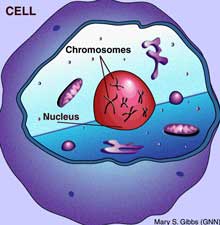Since 2003, many people have learned at least a smidgen about genetics and its relevance to disease and health in the volumes of information written about the Human Genome Project. If you haven't heard of it yet, don't worry. Here is some of the basic information that will be a major factor in health care in the 21st century.
Begun in 1990, the U.S. Human Genome Project was a 13-year effort by the U.S. Department of Energy and the National Institutes of Health. The project originally was planned to last 15 years, but advanced technology helped to accelerate the project so that the goals could be met two years sooner.
These project goals were:
Identify all the approximately 20,000-25,000 genes in human DNA
Determine the sequences of the 3 billion chemical base pairs that make up human DNA
Store this information in databases
Improve tools for data analysis
According to the government web page on the HGP......
What is the Human Genome Project?
Begun formally in 1990, the U.S. Human Genome Project was a 13-year effort coordinated by the U.S. Department of Energy and the National Institutes of Health. The project originally was planned to last 15 years, but rapid technological advances accelerated the completion date to 2003. Project goals
- identify all the approximately 20,000-25,000 genes in human DNA,
- determine the sequences of the 3 billion chemical base pairs that make up human DNA,
- store this information in databases,
- improve tools for data analysis,
- transfer related technologies to the private sector, and
- address the ethical, legal, and social issues (ELSI) that may arise from the project.
A unique aspect of the U.S. Human Genome Project is that it was the first large scientific undertaking to address potential ELSI implications arising from project data.
Another important feature of the project was the federal government's long-standing dedication to the transfer of technology to the private sector. By licensing technologies to private companies and awarding grants for innovative research, the project catalyzed the multibillion-dollar U.S. biotechnology industry and fostered the development of new medical applications.
Landmark papers detailing sequence and analysis of the human genome were published in February 2001 and April 2003 issues of Nature and Science. See an index of these papers and learn more about the insights gained from them.
What's a genome? And why is it important?
- A genome is all the DNA in an organism, including its genes. Genes carry information for making all the proteins required by all organisms. These proteins determine, among other things, how the organism looks, how well its body metabolizes food or fights infection, and sometimes even how it behaves.
- DNA is made up of four similar chemicals (called bases and abbreviated A, T, C, and G) that are repeated millions or billions of times throughout a genome. The human genome, for example, has 3 billion pairs of bases.
- The particular order of As, Ts, Cs, and Gs is extremely important. The order underlies all of life's diversity, even dictating whether an organism is human or another species such as yeast, rice, or fruit fly, all of which have their own genomes and are themselves the focus of genome projects. Because all organisms are related through similarities in DNA sequences, insights gained from nonhuman genomes often lead to new knowledge about human biology.
Can this be helpful to us as parents of a child with Special Needs? Only time will tell.
Be gentle.



No comments:
Post a Comment
Love reading your thoughts. Please leave us a comment.